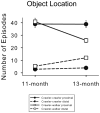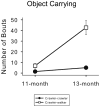Transition from crawling to walking and infants' actions with objects and people
- PMID: 21545581
- PMCID: PMC3163171
- DOI: 10.1111/j.1467-8624.2011.01595.x
Transition from crawling to walking and infants' actions with objects and people
Abstract
Associations between infants' transition to walking and object activities were examined. Fifty infants were observed longitudinally during home observations. At 11 months, all infants were crawlers; at 13 months, half became walkers. Over age, infants increased their total time with objects and frequency of sharing objects with mothers. Bidirectional influences between locomotion and object actions were found. Walking was associated with new forms of object behaviors: Walkers accessed distant objects, carried objects, and approached mothers to share objects; crawlers preferred objects close at hand and shared objects while remaining stationary. Earlier object activities predicted walking status: Crawlers who accessed distant objects, carried objects, and shared objects over distances at 11 months were more likely to walk by 13 months.
© 2011 The Authors. Child Development © 2011 Society for Research in Child Development, Inc.
Figures





References
-
- Adolph KE, Badaly D, Garciaguirre JS, Sotsky R. 15,000 steps: Infants’ locomotor experience. 2010. Manuscript in revision.
-
- Adolph KE, Berger SE. Motor development. In: Kuhn D, Siegler RS, editors. Handbook of child psychology: Vol. 2. Cognition, perception, and language. 6. New York: John Wiley & Sons; 2006. pp. 161–213.
-
- Adolph KE, Berger SE. Physical and motor development. In: Bornstein MH, editor. Developmental science: An advanced textbook. 6. Hillsdale: Erlbaum; (in press)
Publication types
MeSH terms
Grants and funding
LinkOut - more resources
Full Text Sources

